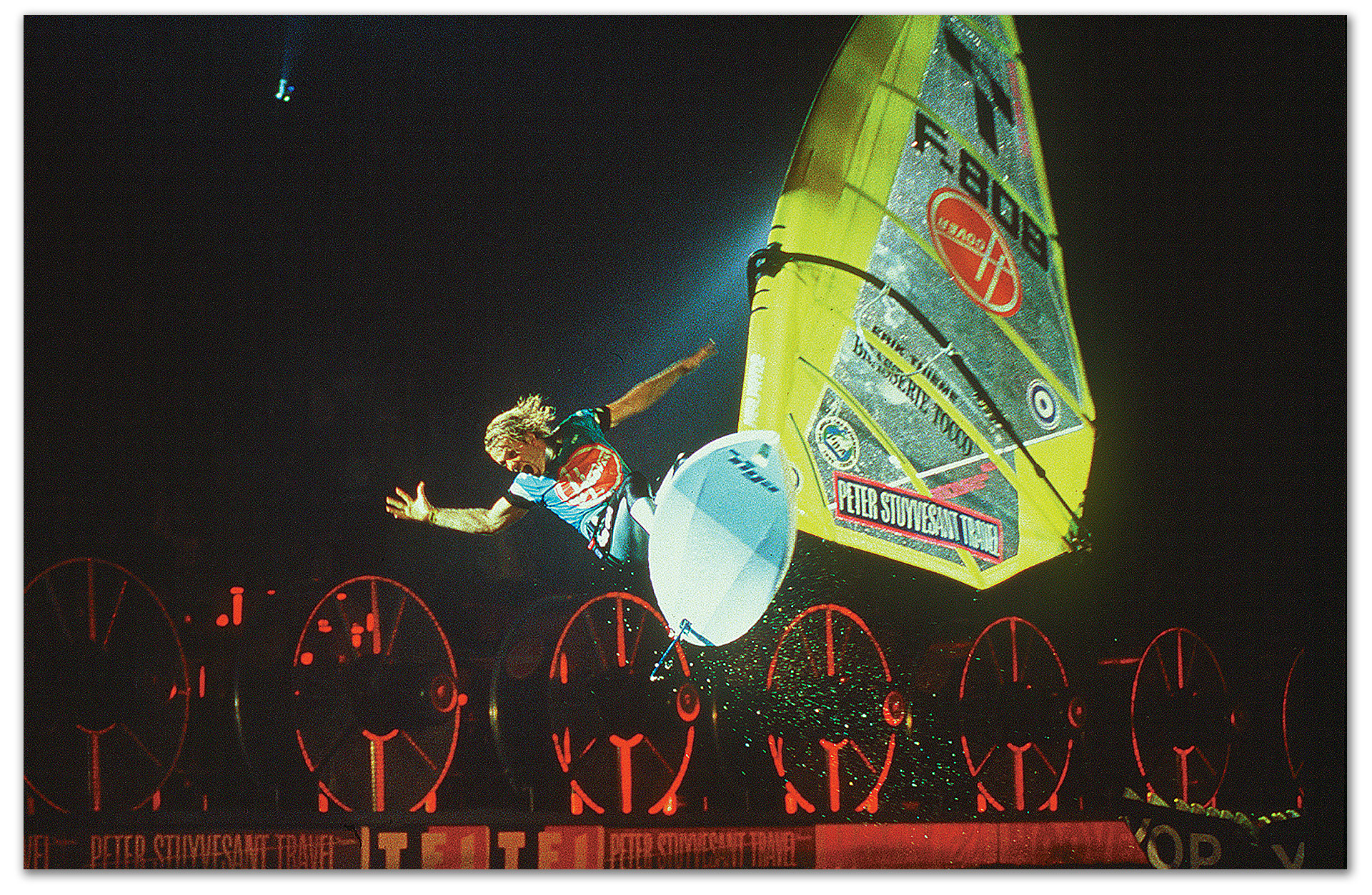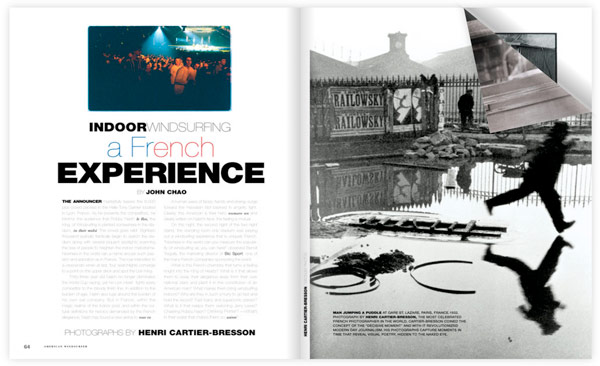
OPENING PHOTOGRAPHS BY Henri Cartier-Bresson, the most celebrated French Photographer in the world. CARTIER-Bresson Coined the concept of the “Decisive Moment” and with it revolutionized modern day journalism. His photographs capture moments in time that reveal visual poetry, hidden to the naked eye.
THE ANNOUNCER masterfully teases the 8,000 plus crowd packed in the Halle Tony Garnier located in Lyon, France. As he presents the competitors, he informs the audience that Robby Naish le Roi, the King, of Windsurfing is planted somewhere in the stadium, in their midst. The crowd goes wild! Eighteen thousand eyeballs frantically begin to search the stadium along with several piquant spotlights scanning the sea of people to heighten the indoor melodrama. Nowhere in the world can a name arouse such passion and adoration as in France. The roar intensifies to a crescendo when at last, four searchlights converge to a point on the upper deck and spot the Lion King.
Thirty-three year old Naish no longer dominates the World Cup racing, yet his Lion Heart fights every competitor to the bloody finish line. In addition to the burden of age, Naish also lugs around the burden of his own sail company. But in France, within the magic realms of the indoor pool, and within the cultural definitions for heroics demanded by the French allegiance, Naish has found a new arena to roar in.
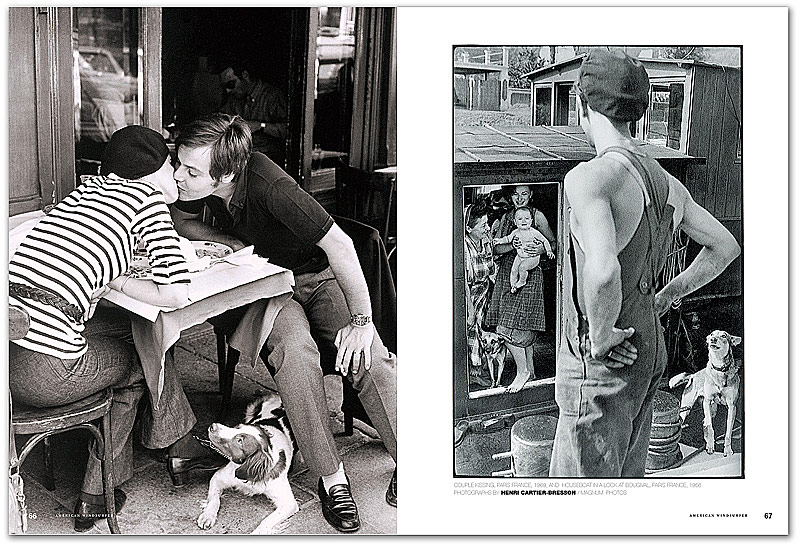
A human wave of faces, hands and energy surge toward the Hawaiian idol basked in angelic light. Clearly, this American is their hero numaro un and clearly written on Naish’s face, the feeling is mutual.
On this night, the second night of the two night stand, the standing room only stadium was playing out a windsurfing experience that is uniquely French. “Nowhere in the world can you measure the popularity of windsurfing as you can here!” observed Benoit Treguilly, the marketing director of Bic Sport, one of the many French companies sponsoring the event.
Advertisement
What is this French chemistry that turns a fading knight into the King of Hearts? What is it that allows them to sway their allegiance away from their own national stars and plant it in the constitution of an American man? What makes them bring windsurfing indoors? Why are they in such a hurry to go fast and hold the record? Fast trains and supersonic planes? What is it that keeps them watching Jerry Lewis? Cheering Robby Naish? Drinking Perrier? —What’s in their water that makes them so soiree?
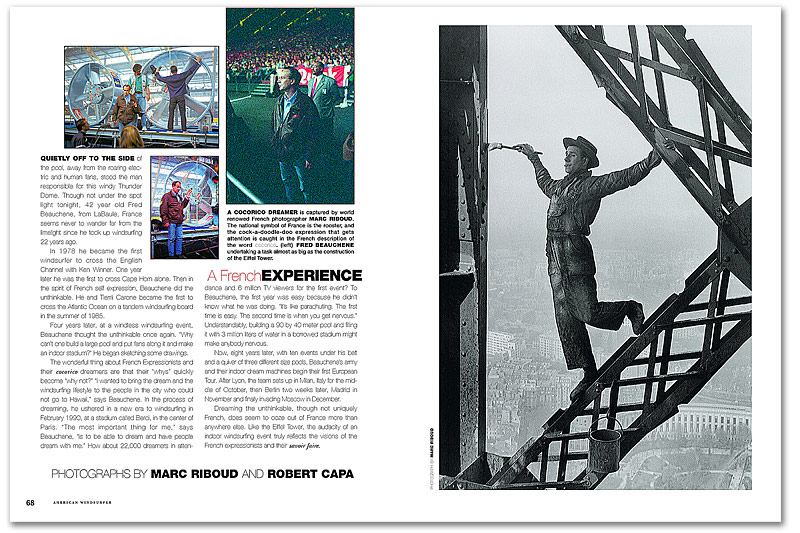
QUIETLY OFF TO THE SIDE of the pool, away from the roaring electric and human fans, stood the man responsible for this windy Thunder Dome. Though not under the spot light tonight, 42 year old Fred Beauchene, from LaBaule, France seems never to wander far from the limelight since he took up windsurfing 22 years ago.
In 1978 he became the first windsurfer to cross the English Channel with Ken Winner. One year later he was the first to cross Cape Horn alone. Then in the spirit of French self expression, Beauchene did the unthinkable. He and Tierrii Carone became the first to cross the Atlantic Ocean on a tandem windsurfing board in the summer of 1985.
Four years later, at a windless windsurfing event, Beauchene thought the unthinkable once again. “Why can’t one build a large pool and put fans along it and make an indoor stadium?” He began sketching some drawings.
The wonderful thing about French Expressionists and their cocorico dreamers are that their “whys” quickly become “why not?” “I wanted to bring the dream and the windsurfing lifestyle to the people in the city who could not go to Hawaii,” says Beauchene. In the process of dreaming, he ushered in a new era to windsurfing in February 1990, at a stadium called Berci, in the center of Paris. “The most important thing for me,” says Beauchene, “is to be able to dream and have people dream with me.” How about 22,000 dreamers in attendance and 6 million TV viewers for the first event? To Beauchene, the first year was easy because he didn’t know what he was doing. “It’s like parachuting. The first time is easy. The second time is when you get nervous.” Understandably, building a 90 by 40 meter pool and filling it with 3 million liters of water in a borrowed stadium might make anybody nervous.
Now, eight years later, with ten events under his belt and a quiver of three different size pools, Beauchene’s army and their indoor dream machines begin their first European Tour. After Lyon, the team sets up in Milan, Italy for the middle of October, then Berlin two weeks later, Madrid in November and finally invading Moscow in December.
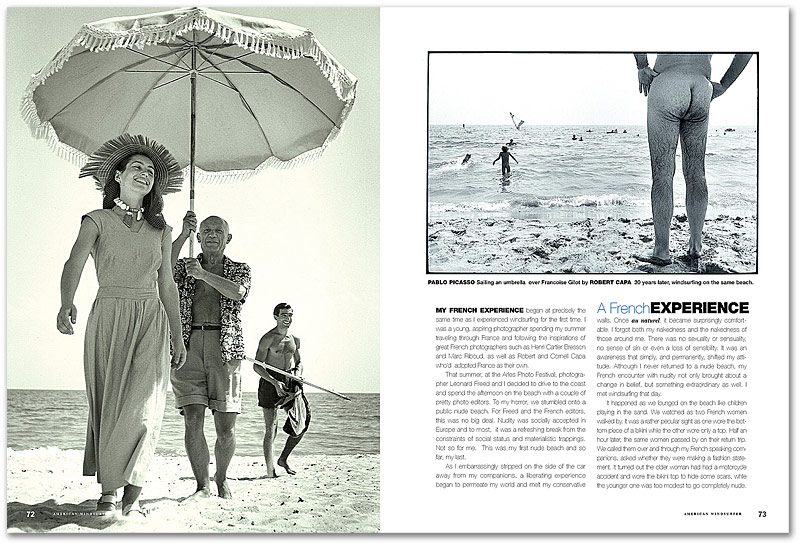
Dreaming the unthinkable, though not uniquely French, does seem to ooze out of France more than anywhere else. Like the Eiffel Tower, the audacity of an indoor windsurfing event truly reflects the visions of the French expressionists and their savoir faire.
MY FRENCH EXPERIENCE began at precisely the same time as I experienced windsurfing for the first time. I was a young, aspiring photographer spending my summer traveling through France and following the inspirations of great French photographers such as Henri Cartier Bresson and Marc Riboud, as well as Robert and Cornell Capa who’d adopted France as their own.
That summer, at the Arles Photo Festival, photographer Leonard Freed and I decided to drive to the coast and spend the afternoon on the beach with a couple of pretty photo editors. To my horror, we stumbled onto a public nude beach. For Freed and the French editors, this was no big deal. Nudity was socially accepted in Europe and to most, it was a refreshing break from the constraints of social status and materialistic trappings. Not so for me. This was my first nude beach and so far, my last.
As I embarrassingly stripped on the side of the car away from my companions, a liberating experience began to permeate my world and melt my conservative walls. Once au naturel, it became surprisingly comfortable. I forgot both my nakedness and the nakedness of those around me. There was no sexuality or sensuality, no sense of sin or even a loss of sensibility. It was an awareness that simply, and permanently, shifted my attitude. Although I never returned to a nude beach, my French encounter with nudity not only brought about a change in belief, but something extraordinary as well. I met windsurfing that day.
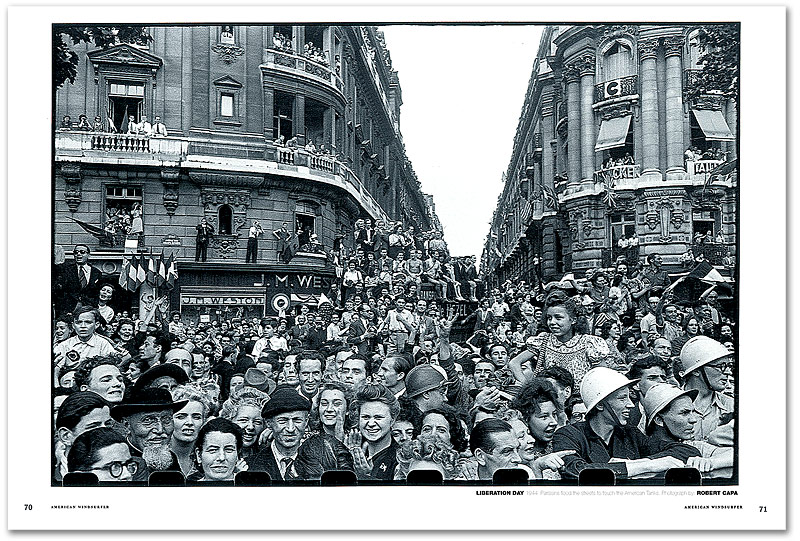
It happened as we lounged on the beach like children playing in the sand. We watched as two French women walked by. It was a rather peculiar sight as one wore the bottom piece of a bikini while the other wore only a top. Half an hour later, the same women passed by on their return trip. We called them over and through my French speaking companions, asked whether they were making a fashion statement. It turned out the older woman had had a motorcycle accident and wore the bikini top to hide some scars, while the younger one was too modest to go completely nude. I asked if I could take a picture and they graciously obliged. They then walked down the beach to a man dragging a long surfboard with a sail attached to it. I studied this naked Frenchman as he said something to the two woman in obvious familiarity. He didn’t linger with them but proceeded to enter the water leaving them standing on the beach. I watched him. He positioned the board, stuck what looked to be a centerboard down the middle of the board, and hopped on while holding a rope attached to the sail. Quickly he hoisted the sail upright and immediately the wind began to fly him out to sea.
Sponsored Links
I watched the windsurfer. He looked great. His arms extended and his naked body draped over the water. He lunged back and danced with the wind and the water. It was magical. I watched him for nearly an hour, oblivious to the cosmic display of flesh surrounding me. Finally, he retired. By this time I had waded out into the water to meet him. I waved at him and with primitive hand signals, asked if I could try it. He smiled, and said oui oui and handed over the windsurfer.
Before letting go, he slapped his hands on the board on each side of the sail. In English, he tells me that this is where I should put my feet. He smiles again and leaves. I climb on the board and immediately fall off. I climb back on, this time aware of the eyes of my companions and a few others on the beach. Still, I roll off the board.
I begin to evaluate the situation. It’s not so much as what I was doing wrong, but whether it was more embarrassing to quit right away or proceed and provide an afternoon’s worth of entertainment for my audience on the beach. Youth has it’s privileges and ignorance is bliss, so I persisted. I kept thinking, “If I give it one more try, I could master it and be like the naked Frenchman.”
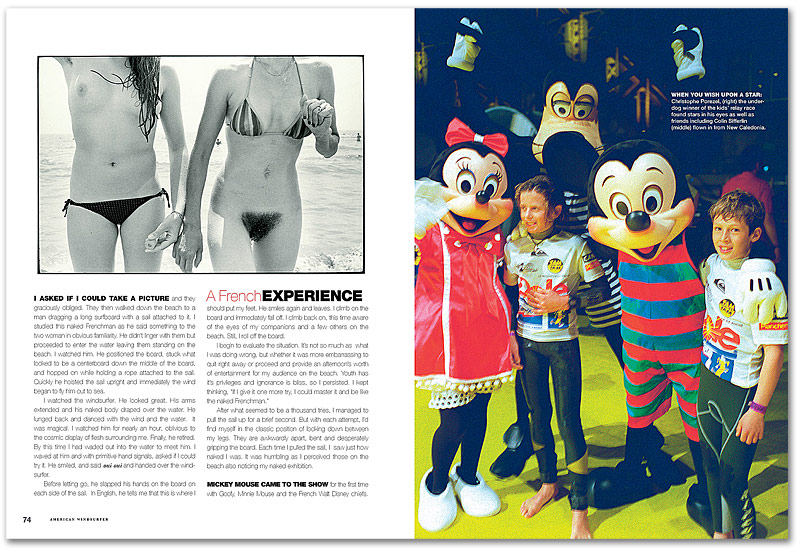
After what seemed to be a thousand tries, I managed to pull the sail up for a brief second. But with each attempt, I’d find myself in the classic position of looking down between my legs. They are awkwardly apart, bent and desperately gripping the board. Each time I pulled the sail, I saw just how naked I was. It was humbling as I perceived those on the beach also noticing my naked exhibition.
MICKEY MOUSE came to the show for the first time with Goofy, Minnie Mouse and the French Walt Disney chiefs. They were there to sponsor a junior relay race with four young sailors flown in for the show, two from France, one from Tahiti and the last from New Caledonia. It was a new twist to an event whose novelty was beginning to dull after years of repetitive choreography. Disney was a perfect new partner. Leave it to the French to make the connection come to life, a connection that was originally made in America by North Sport’s Dave Johnson.
Before the event, the four star-struck young sailors were walking around in a daze of disbelief. Encamped in the same rigging area as their brief but lifelong idols, the young sailors carried their suppressed excitement with a reverence akin to the faithful worshiping in the temple of Hercules.
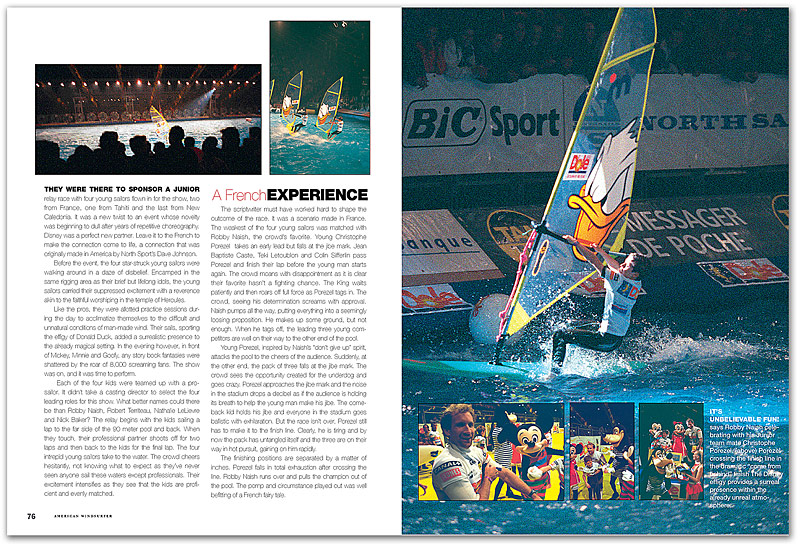
Like the pros, they were allotted practice sessions during the day to acclimatize themselves to the difficult and unnatural conditions of man-made wind. Their sails, sporting the effigy of Donald Duck, added a surrealistic presence to the already magical setting. In the evening however, in front of Mickey, Minnie and Goofy, any story book fantasies were shattered by the roar of 8,000 screaming fans. The show was on, and it was time to perform.
Advertisement
Each of the four kids were teamed up with a pro-sailor. It didn’t take a casting director to select the four leading roles for this show. What better names could there be than Robby Naish, Robert Territeau, Nathalie LeLievre and Nick Baker? The relay begins with the kids sailing a lap to the far side of the 90 meter pool and back. When they touch, their professional partner shoots off for two laps and then back to the kids for the final lap. The four intrepid young sailors take to the water. The crowd cheers hesitantly, not knowing what to expect as they’ve never seen anyone sail these waters except professionals. Their excitement intensifies as they see that the kids are proficient and evenly matched.
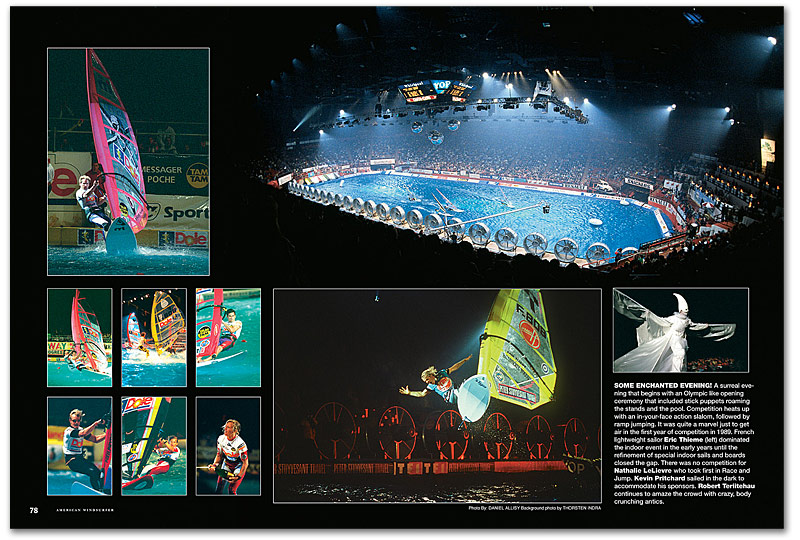
The scriptwriter must have worked hard to shape the outcome of the race. It was a scenario made in France. The weakest of the four young sailors was matched with Robby Naish, the crowd’s favorite. Young Christophe Porezel takes an early lead but falls at the jibe mark. Jean Baptiste Caste, Teki Letoublon and Colin Sifferlin pass Porezel and finish their lap before the young man starts again. The crowd moans with disappointment as it is clear their favorite hasn’t a fighting chance. The King waits patiently and then roars off full force as Porezel tags in. The crowd, seeing his determination screams with approval. Naish pumps all the way, putting everything into a seemingly loosing proposition. He makes up some ground, but not enough. When he tags off, the leading three young competitors are well on their way to the other end of the pool.
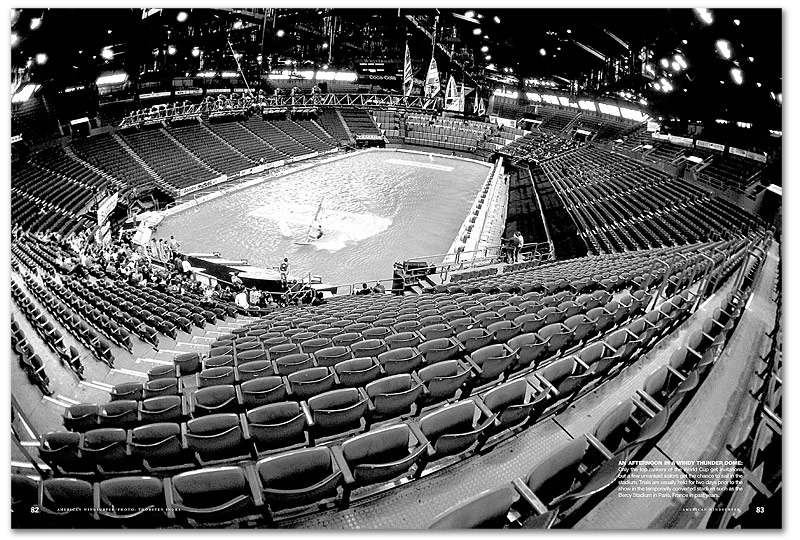
Young Porezel, inspired by Naish’s “don’t give up” spirit, attacks the pool to the cheers of the audience. Suddenly, at the other end, the pack of three falls at the jibe mark. The crowd sees the opportunity created for the underdog and goes crazy. Porezel approaches the jibe mark and the noise in the stadium drops a decibel as if the audience is holding its breath to help the young man make his jibe. The comeback kid holds his jibe and everyone in the stadium goes ballistic with exhilaration. But the race isn’t over, Porezel still has to make it to the finish line. Clearly, he is tiring and by now the pack has untangled itself and the three are on their way in hot pursuit, gaining rapidly.
The finishing positions are separated by a matter of inches. Porezel falls in total exhaustion after crossing the line. Robby Naish runs over and pulls the champion out of the pool. The pomp and circumstance played out was well befitting of a French fairy tale.
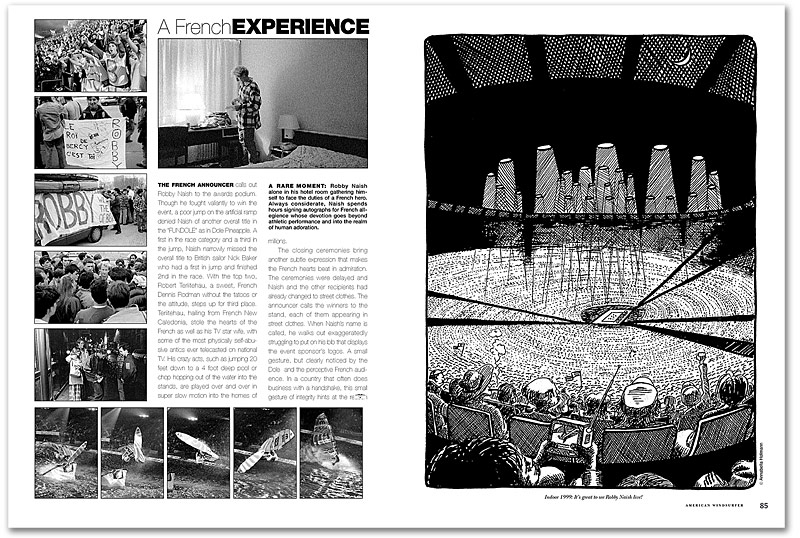
THE FRENCH ANNOUNCER calls out Robby Naish to the awards podium. Though he fought valiantly to win the event, a poor jump on the artificial ramp denied Naish of another overall title in the “FUNDOLE” as in Dole Pineapple. A first in the race category and a third in the jump, Naish narrowly missed the overall title to British sailor Nick Baker who had a first in jump and finished 2nd in the race. With the top two, Robert Teriitehau, a sweet, French Dennis Rodman without the tattoos or the attitude, steps up for third place. Teriitehau, hailing from French New Caledonia, stole the hearts of the French as well as his TV star wife, with some of the most physically self-abusive antics ever telecasted on national TV. His crazy acts, such as jumping 20 feet down to a 4 foot deep pool or chop hopping out of the water into the stands, are played over and over in super slow motion into the homes of millions.
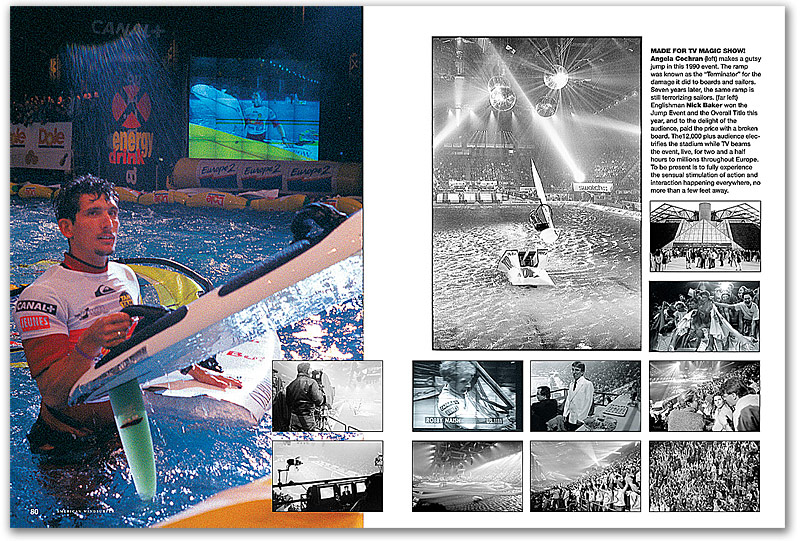
The closing ceremonies bring another subtle expression that makes the French hearts beat in admiration. The ceremonies were delayed and Naish and the other recipients had already changed to street clothes. The announcer calls the winners to the stand, each of them appearing in street clothes. When Naish’s name is called, he walks out exaggeratedly struggling to put on his bib that displays the event sponsor’s logos. A small gesture, but clearly noticed by the Dole and the perceptive French audience. In a country that often does business with a handshake, this small gesture of integrity hints at the reason why Robby Naish est le roi du surfing in France.


